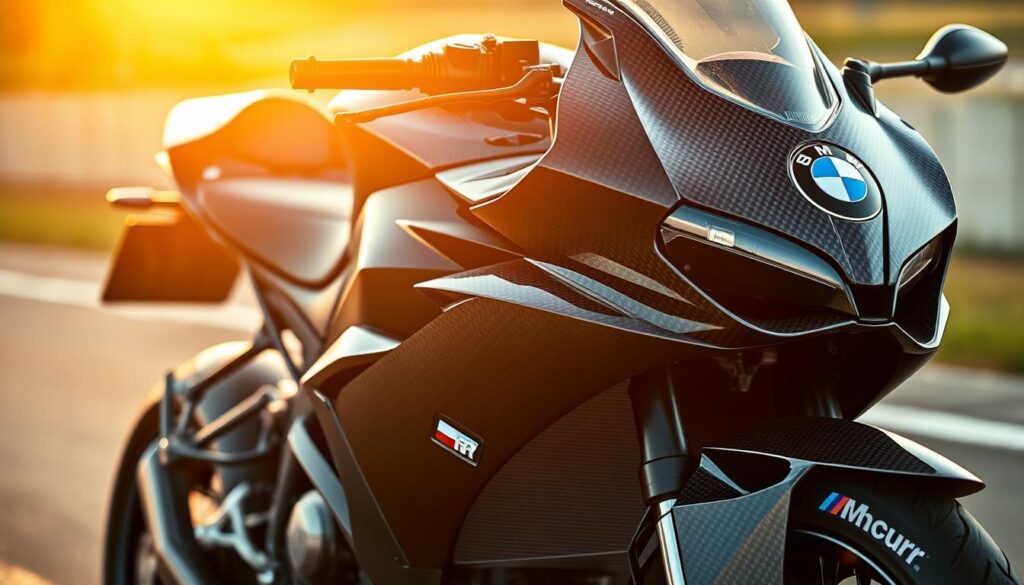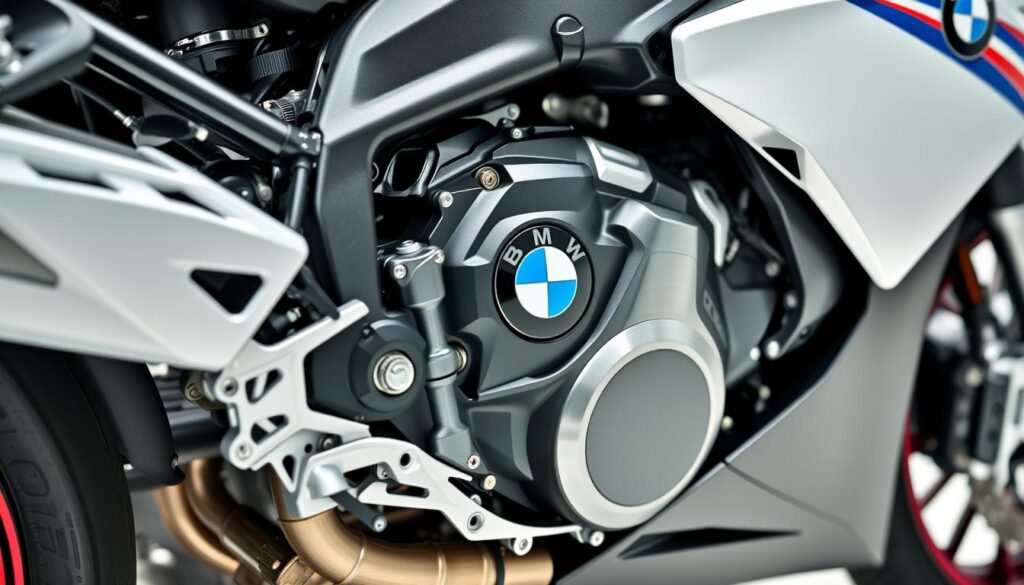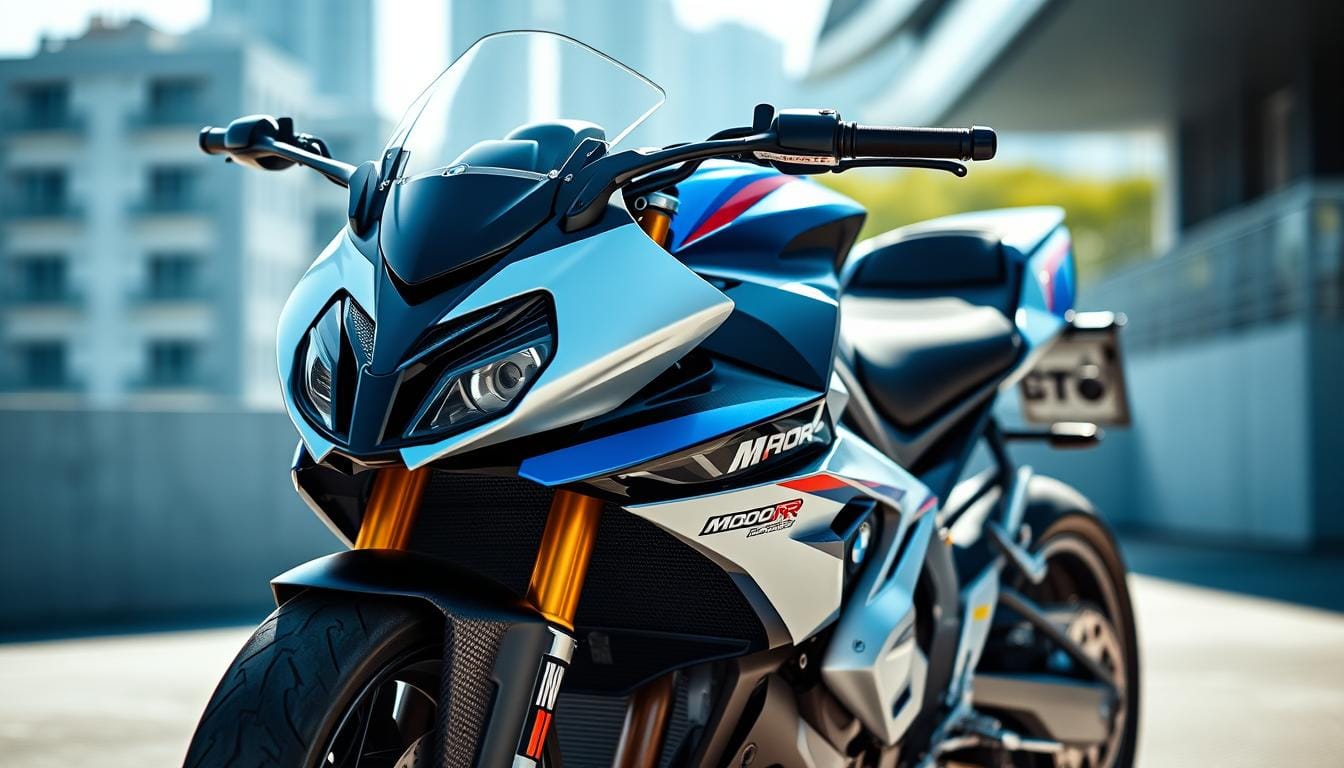Discover the BMW M1000RR: Specifications and Pricing
Table of Contents
What makes a motorcycle truly exceptional? Is it raw speed, cutting-edge technology, or the thrill of riding on both the track and the road? The M1000RR answers all these questions with its unparalleled design and engineering.
As BMW Motorrad’s flagship homologation superbike, the BMW 1000 series has set new standards in the world of high-performance motorcycles. The 2023 model boasts a 999cc inline-four engine, delivering up to 212 bhp and a top speed of 195 mph. Its aerodynamic carbon fairing and race-derived electronics make it a force to be reckoned with.
Priced as a premium offering, this motorcycle combines track-focused performance with road-friendly features like heated grips and cruise control. Whether you’re chasing lap times or cruising the open road, the BMW 1000 is designed to excel in every scenario.
Introduction to the M1000RR

When it comes to blending racing heritage with cutting-edge technology, few motorcycles stand out like the BMW M1000RR. As the first motorcycle project from the BMW M Division, it embodies the brand’s commitment to performance and innovation. Built as a homologation special for World Superbike racing, this machine is designed to dominate both the track and the road.
One of the standout features is its lightweight construction. The use of carbon fiber ensures a wet weight of just 193kg, making it agile and responsive. This material not only reduces weight but also enhances durability, a crucial factor for high-speed performance.
Aerodynamics play a key role in the 2023 model’s design. The redesigned fairing and winglets generate up to 22.6kg of front downforce at 186mph, improving stability and control. These advancements contribute to a 5mph increase in top speed, making it one of the fastest bikes in its class.
For riders, the BMW 1000 offers advanced technology to enhance the experience. The 6.5″ TFT dash provides clear, customizable information, while Pro riding modes and a GPS lap timer cater to both amateur and professional users. Real-world testing at Cadwell Park demonstrated its stability even at speeds exceeding 160mph, proving its capabilities in demanding conditions.
| Feature | Specification |
|---|---|
| Weight | 193kg (wet) |
| Front Downforce | 16.3kg-22.6kg at 186mph |
| Top Speed Increase | 5mph (2023 model) |
| Display | 6.5″ TFT Dash |
| Testing Location | Cadwell Park |
BMW M1000RR: A Closer Look at the Engine

The heart of any high-performance motorcycle lies in its engine, and this model is no exception. Designed for precision and power, the 999cc inline-four engine is a marvel of engineering. It produces an impressive 212.1PS at 14,500rpm and 113Nm of torque at 11,000rpm, ensuring thrilling performance on both the road and the track.
Engine Specifications
This engine features several upgrades to enhance its performance. Increased compression, forged pistons, and revised camshafts work together to deliver unmatched power and efficiency. The titanium exhaust system not only reduces weight by 7.7lbs but also ensures compliance with Euro 5 emissions standards.
Power delivery is smooth and consistent, with 83% of the torque available from 6,000rpm to the redline. This makes the bike manageable at lower speeds while providing a thrilling rush at higher RPMs. Whether you’re cruising or pushing the limits, the engine’s responsiveness is always on point.
Performance on the Road and Track
On the road, the engine’s low-RPM torque ensures a comfortable and controlled ride. However, when you hit the track, the top-end power feels like a turbo button, delivering an adrenaline-pumping experience. The bike’s fuel efficiency is also noteworthy, achieving 43mpg (UK) or 15.38kmpl (India) despite its high-performance capabilities.
| Feature | Specification |
|---|---|
| Engine Type | 999cc Inline-Four |
| Power Output | 212.1PS @14,500rpm |
| Torque | 113Nm @11,000rpm |
| Exhaust System | Titanium, 7.7lbs Weight Reduction |
| Fuel Efficiency | 43mpg (UK) / 15.38kmpl (India) |
Design and Aerodynamics
The design of a motorcycle plays a crucial role in its performance and appeal. Every curve and component is engineered to enhance speed, stability, and rider comfort. This section dives into the key elements that make this machine stand out.
Carbon Fiber Fairing and Winglets
The use of carbon fiber is a game-changer in motorcycle design. The M Carbon package includes a lightweight fairing, wheels, chain guard, and tank covers. This material not only reduces weight but also improves durability, making it ideal for high-speed performance.
One of the most innovative features is the aerodynamic winglets. These generate up to 22.6kg of front downforce at 186mph, preventing wheelies and improving stability. The redesigned fairing also manages airflow effectively, reducing wind buffeting for a smoother ride.
Ergonomics and Rider Comfort
While the bike is race-focused, it doesn’t compromise on comfort. The standard M seat is designed for aggressive riding, but an optional comfort seat is available for longer journeys. The seat height of 832mm ensures a balanced riding position for most riders.
Practical touches like a USB port under the seat and optional heated grips add convenience. The carbon front mudguard with brake cooling ducts enhances both aesthetics and functionality. These features make the bike versatile for both track and road use.
| Feature | Detail |
|---|---|
| Carbon Components | Fairing, wheels, chain guard, tank covers |
| Winglet Downforce | 22.6kg at 186mph |
| Seat Height | 832mm |
| Practical Features | USB port, optional heated grips |
BMW M1000RR’s Advanced Electronics
Modern motorcycles are defined by their advanced electronics, and this model sets a new benchmark. The 6-axis IMU (Inertial Measurement Unit) is the backbone of its control systems, enabling features like cornering ABS, wheelie control, and slide mitigation. These technologies ensure stability and safety, even at high speeds.
Riding Modes and Traction Control
The electronic suite offers multiple riding modes, including Rain, Road, Dynamic, and Race. For serious racing enthusiasts, there are three programmable Race Pro modes. Each mode adjusts throttle response, traction control, and ABS settings to suit different conditions. This flexibility makes the bike adaptable for both track and road use.
Quick Shifter and Launch Control
The bidirectional quick shifter allows seamless up and down shifts above 2,500rpm, enhancing performance during aggressive riding. Launch control takes it a step further, enabling 14,000rpm starts with a claimed 0-60mph time of just 2.5 seconds. These features are designed to maximize acceleration and efficiency, whether you’re on the track or the open road.
Additionally, the brake slide mitigation system detects rear-wheel lift during hard stops, ensuring stability and control in extreme braking scenarios. When compared to competitors like the Ducati Panigale V4R, this system stands out for its precision and reliability.
Suspension and Braking System
A motorcycle’s performance hinges on its ability to handle speed and control with precision. The suspension and brake systems are the backbone of this capability, ensuring stability and safety in every ride.
Marzocchi Suspension Setup
The 45mm Marzocchi forks offer 4.7 inches of travel, providing a fully adjustable setup for riders. Unlike semi-active alternatives, these components allow for fine-tuning to match specific riding conditions. Whether on the track or the road, the suspension ensures a smooth and responsive experience.
Carbon mudguard ducts play a key role in preventing brake fade during intense track use. This design keeps the system cool, maintaining consistent performance even under heavy stress.
Nissin Brakes and ABS
The Nissin 4-piston calipers deliver exceptional stopping power, comparable to Brembo Stylema but at a lower cost. These brakes are paired with cornering ABS, which enhances safety by preventing wheel lock during aggressive maneuvers.
Wheel options include 17-inch carbon and forged aluminum variants. While carbon wheels reduce weight, aluminum offers durability and cost-effectiveness. However, it’s worth noting that the stock ABS cannot be fully disabled, which may limit track-focused customization.
BMW M1000RR’s Weight and Handling
The balance between weight and handling defines a motorcycle’s performance. For a superbike, every gram saved translates to better agility and speed. This model achieves a wet weight of just 193kg, thanks to its lightweight construction and advanced materials.
Lightweight Construction
Key parts like carbon wheels, titanium fasteners, and a lithium battery contribute to significant weight savings. For instance, the carbon wheels alone reduce weight by 7.7lbs, enhancing the bike’s responsiveness. These materials not only cut mass but also improve durability, ensuring peak performance on the track.
Chassis Dynamics
The aluminum twin-spar frame, derived from the S1000RR, is engineered for stability. With a 23.9° rake angle, it offers a slight increase over the S1000RR’s 23.1°, improving straight-line stability. However, this setup can result in a harsher ride on rough roads, a trade-off for track-focused precision.
Weight distribution is another critical factor. With a full tank, the front/rear split is 52.3/47.7%, ensuring balanced handling. This setup is so effective that MotoAmerica teams use the stock chassis in the Superbike class, a testament to its engineering.
“The combination of lightweight materials and precise chassis geometry makes this bike a standout in its class.”
While the focus is on performance, the rear end’s design ensures stability during aggressive maneuvers. Whether on the track or the road, the bike’s handling remains sharp and predictable, making it a top choice for riders who demand the best.
BMW M1000RR vs. Competitors
In the world of high-performance motorcycles, competition drives innovation. The BMW M1000RR faces stiff rivalry from the Ducati Panigale V4 and the Honda CBR1000RR-R. Each bike brings unique strengths to the table, making the choice a matter of priorities for riders.
Power-to-Weight and Aerodynamics
When it comes to power, the BMW M1000RR delivers 212.1PS with a power-to-weight ratio of 1.09hp/kg. The Ducati Panigale V4 edges slightly ahead with 215bhp and a 1.12hp/kg ratio. Meanwhile, the Honda CBR1000RR-R matches closely at 214bhp.
Aerodynamics also play a crucial role. The BMW M1000RR features winglets that generate up to 22.6kg of downforce at 186mph. In contrast, the Ducati Panigale V4 relies on fairing ducts for stability. These design choices impact handling and top-speed performance.
Electronics and Maintenance
Electronics are a key differentiator. The BMW M1000RR offers Race Pro modes for customizable performance. The Honda CBR1000RR-R counters with Öhlins Smart EC, a semi-active suspension system. Both systems enhance control but cater to different riding styles.
Maintenance costs vary significantly. The BMW M1000RR comes with a 3-year warranty, while the Ducati Panigale V4 requires more frequent service intervals. For riders focused on the road, this can be a deciding factor.
Track Readiness
For track enthusiasts, the BMW M1000RR offers the M Competition Package, including lightweight components and advanced tuning. The Honda CBR1000RR-R provides an HRC kit for similar upgrades. Both bikes are ready to dominate the circuit, but the choice depends on personal preference.
| Feature | BMW M1000RR | Ducati Panigale V4 | Honda CBR1000RR-R |
|---|---|---|---|
| Power | 212.1PS | 215bhp | 214bhp |
| Power-to-Weight | 1.09hp/kg | 1.12hp/kg | 1.10hp/kg |
| Aerodynamics | Winglets | Fairing Ducts | Standard Fairing |
| Electronics | Race Pro Modes | Ducati Traction Control | Öhlins Smart EC |
| Maintenance | 3-Year Warranty | Frequent Service | Standard Warranty |
Pricing and Value Proposition
Understanding the cost and value of a high-performance motorcycle is essential for any enthusiast. The price reflects not just the machine’s capabilities but also its exclusivity and long-term benefits. This section breaks down the standard model and the M Competition package, helping riders make an informed decision.
Standard Model Pricing
The base model is estimated at $32,000 in the US. This includes advanced electronics, a 999cc inline-four engine, and aerodynamic features. For riders seeking a balance between performance and affordability, this option delivers exceptional value.
Standard equipment includes a 6.5″ TFT dash, heated grips, and multiple riding modes. These features make it suitable for both road and track use, offering versatility without compromising on performance.
M Competition Package
For those who demand more, the M Competition package is available at $37,500. This upgrade adds premium components like billet levers, carbon wheel covers, and a race ECU. The inclusion of a DLC chain and GPS lap timer enhances both performance and convenience.
Carbon parts reduce weight, improving agility and speed. The competition package is designed for serious riders who prioritize track performance and exclusivity.
When comparing value, the 3-year warranty stands out against competitors like Ducati, which require more frequent servicing. Limited production numbers also contribute to higher resale value, making it a smart investment for enthusiasts.
| Feature | Standard Model | M Competition Package |
|---|---|---|
| Price | $32,000 | $37,500 |
| Key Upgrades | Heated grips, TFT dash | Carbon parts, DLC chain, race ECU |
| Warranty | 3 years | 3 years |
| Resale Value | High | Very High |
Conclusion
For those seeking a blend of cutting-edge technology and race-inspired performance, this motorcycle stands as a top contender. Its aerodynamic innovation, race-ready engine, and advanced electronics suite make it a standout choice for riders who demand precision and power.
However, it’s not without its drawbacks. The high cost, firm suspension, and cold tire performance may deter casual enthusiasts. This bike is best suited for experienced racers and track-day enthusiasts who value its World Superbike-derived technology.
Looking ahead, potential updates, such as hybrid tech from the TVS partnership, could further enhance its appeal. For now, it remains a niche option, offering unmatched performance for those willing to invest the time and money.
In summary, the BMW 1000 is ideal for seasoned riders seeking a machine that excels on the track while maintaining road-friendly features. Its blend of innovation and performance ensures it remains a top choice in its class.

